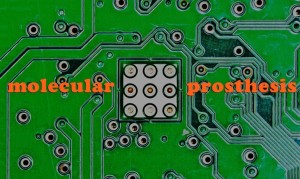
A new type of genetic circuit implanted in mice can treat psoriasis, an inflammatory skin disease.
Gene circuits created in the past typically monitored only whether a metabolic molecule A was present in their environment; if so, they produced a metabolic molecule X as a response. The new, more complex circuit can detect two molecules, A and B, simultaneously, and only if both are present does it produce the molecules X and Y.
“We have used cellular components to build an AND logic gate, as is familiar in electronics and without which computers could not function,” says Martin Fussenegger, a professor at ETH Zurich who led the project.
When researchers implanted a circuit with an AND gate of this kind into mice, the circuit was able to successfully suppress phases of psoriasis in the mouse model.
Fussenegger calls them molecular prosthetics: cells with specially developed gene circuits that can be implanted into an organism, where they take over metabolic functions that the organism cannot perform itself.
The new molecular prosthesis uses the language by which immune cells in the body communicate with one another: the language of the numerous messenger molecules that the immune cells can both produce and detect.
BACKUP SUPPORT FOR THE IMMUNE SYSTEM
The different cells of the immune system are involved in two ways during a psoriasis phase. First, they are responsible for triggering an inflammatory response by increasing the production of various messengers, including those referred to as TNF and IL-22. Second, at a later point, they produce a series of messengers that cause the inflammation to fade away again, among them IL-4 and IL-10.
The circuit developed by the ETH Zurich researchers can detect the inflammatory molecules TNF and IL-22. If (and only if) these two messengers are present simultaneously, the circuit produces the anti-inflammatory molecules IL-4 and IL-10.
“In this way, our molecular prosthesis helps the immune system to suppress the inflammatory response,” explains Fussenegger.
DESIGNER CELLS IN A POROUS CAPSULE
The scientists took tiny porous capsules made of algal gelatin and encased 200 cells of a human cell line with this gene circuit in each capsule. They then injected 6,000 of these minute capsules into the abdomens of mice. New blood vessels formed naturally and connected the capsules to the bloodstream.
The scientists used medicine to trigger an inflammatory response, similar to psoriasis, in the skin of the mice. They then compared the mice into which “designer cell capsules” had been implanted to those without capsules. Only the latter showed symptoms of inflammation. The implant suppressed the inflammatory disease successfully.
They report their findings in Science Translational Medicine.
The symptoms of psoriasis—inflamed, itchy, and sometimes flaky areas of skin—are usually combated with an ointment that is applied locally. Treat typically begins when symptoms flair up.
“This means that with the existing therapies, we are practically always lagging behind the symptoms,” says Fussenegger.
The gene circuit implants, on the other hand, lend themselves well to prevention.
“The circuit begins producing anti-inflammatory messengers at an early stage—when a phase is looming at the level of inflammatory messengers, instead of waiting until skin rashes appear.”
OTHER INFLAMMATORY DISEASES
The successful experiments in mice were a feasibility study, says Fussenegger. It’s still not clear if designer cells of this kind can be used in humans. However, he says, it is conceivable that such cells will one day also be implanted into psoriasis patients. Since growth in connective tissue could cut the implant off from the bloodstream over time, a doctor would probably have to replace it every few months.
Biological circuits of this kind with AND gates may also be suitable for other diseases.
“Chronic inflammatory diseases are a good example of the type of disease that cannot be diagnosed by measuring a single molecule,” says Fussenegger.
However, generally such diseases could be diagnosed using a designer cell that measures the profile of several messengers in the bloodstream. And if this designer cell were also to produce therapeutic molecules, it would open up promising treatment options for a wide range of diseases in the future.
Source: ETH Zurich and Futurity.org








